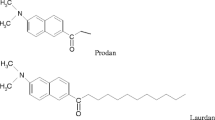Summary.
Two model compounds for the green fluorescent protein chromophore were prepared. One of them incorporates the natural 4-hydroxybenzylidene group of the natural tyrosin derived chromophore, the other one bears a methyl group instead of the hydroxy group. Whereas the photochemically prepared (E)-diastereomer of the first compound very effectively reverted thermally (room temperature) to the thermodynamically stable (Z)-diastereomer, the (E)-diastereomer of the second derivative proved to be stable even at elevated temperatures for more than a day. This finding can be rationalized by constructing the appropriate resonance structures showing that only in the first case an effective delocalization enables partial single bond character of the benzylidene double bond. From the standpoint of chemical etiology, only Nature’s choice of the tyrosin derived chromophore of the green fluorescent protein provides an efficient radiationless thermal relaxation channel for the unwanted photo-diastereomerization product formed after excitation besides the dominating fluorescence channel of its chromophore.
Similar content being viewed by others
References
O Shimomura (1979) FEBS Lett 104 220 Occurrence Handle10.1016/0014-5793(79)80818-2 Occurrence Handle1:CAS:528:DyaE1MXlsFejtL0%3D
H Charbonneau KA Walsh RO McCann FG Prendergast MJ Cormier TC Vanaman (1985) Biochem 24 6762 Occurrence Handle1:CAS:528:DyaL28XitlGm
M Zimmer (2002) Chem Rev 102 759 Occurrence Handle10.1021/cr010142r Occurrence Handle1:CAS:528:DC%2BD38Xps1WmtQ%3D%3D
Heim R, Cubitt AB, Tsien RY (1995) Nature 373: 663; Niwa H, Inouye S, Hirano T, Matsuno T, Kojima S, Kubota M, Ohashi M, Tsuji FI (1996) Proc Natl Acad Sci 93: 13617
Ward WW, Bokman SH (1982) Biochem 21: 4535; Webber NM, Litvinenko KL, Meech SR (2001) J Phys Chem B 105: 8036
X He AF Bell PJ Tonge (2003) FEBS Lett 549 35 Occurrence Handle10.1016/S0014-5793(03)00761-0 Occurrence Handle1:CAS:528:DC%2BD3sXmt1Gqsrg%3D
H Falk K Grubmayr O Hofer F Neufingerl JM Ribó (1976) Monatsh Chem 107 831 Occurrence Handle1:CAS:528:DyaE2sXntFCgug%3D%3D
J Plöchl (1883) Ber Dtsch Chem Ges 16 2815
S Kojima H Ohkawa T Hirano S Maki H Niwa M Ohashi S Inouye FI Tsuji (1998) Tetrahedron Lett 39 5239 Occurrence Handle10.1016/S0040-4039(98)01031-4 Occurrence Handle1:CAS:528:DyaK1cXkt1KksrY%3D
H Falk (1989) The Chemistry of Linear Oligopyrroles and Bile Pigments Springer Wien New York 521
Author information
Authors and Affiliations
Corresponding author
Rights and permissions
About this article
Cite this article
Hager, B., Schwarzinger, B. & Falk, H. Concerning the Thermal Diastereomerization of the Green Fluorescent Protein Chromophore. Monatsh. Chem. 137, 163–168 (2006). https://doi.org/10.1007/s00706-005-0418-4
Received:
Accepted:
Published:
Issue Date:
DOI: https://doi.org/10.1007/s00706-005-0418-4




